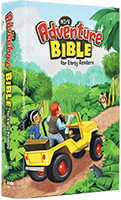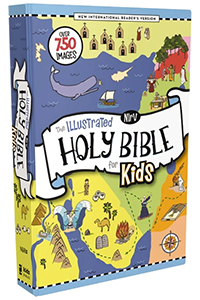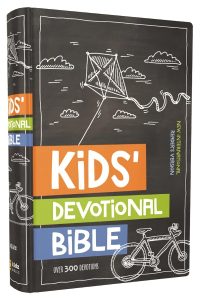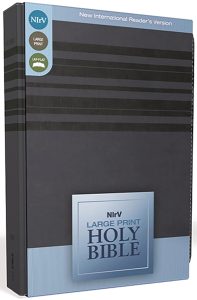When God first gave the Bible to his people, he used their languages. To this day, God wants us to understand his Word by spending time reading it in our own language and growing to know and love him more and more.
The New International Reader’s Version (NIrV) opens the door for new Bible readers of all ages and abilities to understand God’s Word. This version is based on the world’s most-read and trusted modern English translation, the New International Version (NIV).
Wherever possible, the NIrV uses the text of the NIV but adapts it for reading at a third-grade level. In cases where phrases or words might be difficult to understand, words easier to understand have been used. And sentences are shorter, which is helpful for early readers and others who struggle with the English language. Throughout the translation, each verse has been meticulously evaluated in light of the meaning of the original languages in which the Bible was written.
Who is the NIrV for?
The New International Readers Version is ideal for readers of all ages including:
- Children ages 6 to 10
- Those learning English as a second language
- Adults learning to read later in life
- Readers with learning disabilities
- Those simply wanting a version that is easier to read and understand
- The NIrV is also a natural stepping-stone to the NIV as readers become more proficient in their reading abilities and understanding of the English language.
The Lord has blessed the New International Version in a wonderful way. He has used it to help millions become stronger believers and to lead many to put their faith in Jesus. We hope and pray that the NIrV also will help readers in these ways, and we give God all the glory.
Five Fundamentals Make for a Firm Foundation of the NIrV
Readable — written at a third-grade reading level
Children are taught to read and memorize the Bible, but comprehension is frequently difficult, if not impossible, due to the reading level of the Bible being used. In addition, many adults, including those for whom English is a second language, also struggle with reading. The NIrV has been designed to relieve this frustration many children and adults experience and help them to understand the Word of God.
The NIrV is written at a third-grade reading level. Sentence structure, grammar, syntax, and word selection are all carefully reviewed to ensure maximum comprehension while retaining Biblical accuracy. Children 10 years of age or younger will find the NIrV more enjoyable to read than other Bible versions because they will be able to understand what they are reading. Adults who are learning to read will also find the NIrV a perfect resource for Bible reading and study.
Understandable — carefully selected words and unique features enhance reading comprehension
Throughout the work to make the New International Reader’s Version a more readable translation, a heavy emphasis was also placed on making it more understandable. Literary experts and educators working on the NIrV examined both sentence structure and word choices, searching for every possible opportunity to clarify the Scriptures for the early reader and others who struggle with the English language.
- Other features were also examined to ensure maximum comprehension and minimize reader confusion.
- A Bible dictionary is included with every NIrV Bible. This dictionary explains important theological terms that even young readers need to learn, such as grace and sacrifice.
- All footnotes have either been moved or removed. When a verse quotes another part of Scripture, the reference appears right after the verse. Several verses that do not appear in the oldest available manuscripts can be found in the preface.
- Sectional headings are numerous to assist the reader in following the flow of the text.
- Other special helps are included in both the children’s and adult editions to help encourage Bible reading and comprehension.
Compatible — closely tied to the New International Version
The NIrV is a simplification of the NIV, the most widely read and trusted modern English Bible translation in the world. The NIV enjoys a widespread reputation as the best combination of accuracy and readability. It’s true to the original languages of God’s Word and true to the language of the contemporary reader. However, its seventh-grade reading level, while perfect for most adults, does make reading comprehension difficult for new readers and others who struggle with the English language. For years, prior to the release of the NIrV, people had been requesting a simpler NIV suitable for such readers. The NIrV was created to provide just such a translation.
Also, because the NIrV is based on the NIV, it can make it much easier for children and others to transition to the NIV as their reading skills improve.
Reliable — a multi-denominational effort by over 40 Bible translators and literary experts
Many of the same people who translated the NIV participated in the development of the NIrV. In addition, literary experts and educators specializing in elementary education were involved to ensure the best possible product for the early reader. Everyone who participated in the translation of the NIrV followed the NIV guidelines for accuracy, clarity, and readability, and the NIV was constantly referenced throughout the process. When questions about an appropriate simplification arose, the original Greek, Hebrew, and Aramaic Biblical texts were consulted. All simplification work was approved by a final review committee composed of several members of the Committee on Bible Translation, the group responsible for the NIV translation. This extensive committee structure, with its built-in checks and balances, assures Scriptural integrity and literary and stylistic excellence.
In total, almost 40 people from 14 denominations worked together to make the New International Reader’s Version a reality.
Trustworthy — recommended by top Bible scholars
The NIrV is endorsed by leading Bible scholars, preachers and ministry leaders including these Christian leaders and academians:
The New International Reader’s Version offers us a powerful combination of faithfulness to the original languages and true contemporary language that is at once accurate, elegant, and compelling. Many translations attempt this goal; few do it well. The NIrV eliminates technical jargon and archaic words that are rarely used today and avoids complex constructions that alienate many readers from the scriptures. This translation reads the way we speak — and because of this, it will speak directly to its many readers. Again and again I found myself looking at favorite verses and admiring how this translation offers something fresh, unexpected and inspiring. I am confident it will be used widely and treasured for many years to come.
— Gary M. Burge, Ph.D., Professor of New Testament, Wheaton College & Graduate School
I highly recommend the revised NIrV Bible to parents and church leaders. It’s the perfect Bible for today’s kids. I’m highly impressed with the updates that have made to help the Bible come to life for children.
— Ryan Frank, CEO, KidzMatter, Publisher, KidzMatter Magazine
The NIrV meets a crying need. Its simplicity, clarity and accuracy put God’s Word within reach of millions of persons who find standard translations beyond their grasp. They include children, of course, but equally important are educationally deprived adults and the multitiudes here and abroad for whom English is a second language.
— Dr. David Hubbard, Former President/Old Testament Professor Emeritus, Fuller Theological Seminary
There is nothing better than introducing future generations to the Word of God in a tangible way. The translation committee has brought to life the Bible in a translation that will make it understandable for kids so they can apply it to their everyday lives. If you are looking for a version for elementary age students then I would highly recommend the NIrV Bible for your children. Watch your kids grow through God’s Word to be everything God has designed them to be.
— Craig Johnson, Director of Ministries, Lakewood Church
The New International Readers Version is extremely easy to understand, and it maintained the integrity of the Biblical text, but on a level appropriate for the desired age. I think you have hit on a winner here!
— Pastor Mike Johnson, Director of Childhood Leadership Development, Fellowship Church
Children (and adults) will love the NIrV. This version is accurate to the original Hebrew, Aramaic, and Greek as well as very readable. What makes me most excited is that the NIrV will encourage many to read the Bible longer and more frequently. I love it, and I know that my children and my grandchildren will love it as well.
— Tremper Longman III, Robert H. Gundry Professor of Biblical Studies, Westmont College
Translation is a difficult and never-ending task, but the NIrV is a significant achievement. The goal was to prepare an accessible translation, and the translators did the job well. Here is a translation that allows people easy entrance into hearing the Word of God.
– Klyne Snodgrass, Paul W. Brandel Professor of New Testament Studies, North Park Theological Seminary
Significant NIrV Translation Development and Publishing Milestones
1990
The NIrV Committee met for the first time to discuss the vision of developing a translation, based on the NIV, specifically to meet the needs of early readers and others who struggle with the English language.
1991
The NIrV Committee established the translation guidelines of 1. a third-grade reading level, and 2. a translation that would function as a stepping-stone to the NIV.
1994
The translation’s name, New International Reader’s Version (NIrV) was announced by the International Bible Society (now Biblica) and the NIrV Holy Bible, New Testament was published.
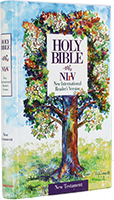
1996
The NIrV Holy Bible was published, the first full NIrV Bible.
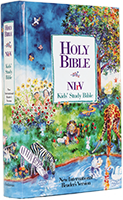
1998
The first revision came just two years later in order to incorporate the significant improvements made to the NIV at that time.
2014
A revised edition was published to reflect the revisions made to the NIV in 2011. These changes were a result of the most recent advances in biblical scholarship as well as a thorough consideration of changes in the English language. It was important for the NIrV to also benefit from these updates.
